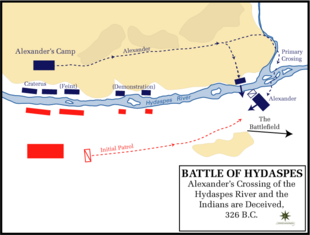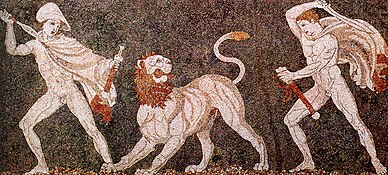Boukephala and Nikaia
The likely location of Boukephala and Nikaia in modern-day Pakistan | |
| History | |
|---|---|
| Builder | Craterus, on the order of Alexander the Great |
| Founded | 326 BC |
| Periods | Hellenistic and Mauryan |
Boukephala (
It is not certain which settlement had which name. Built on the site of the battlefield, the city on the eastern bank was most likely called Nikaia (from nike, lit. 'victory'), while its western companion was probably named after Alexander's horse Bucephalus, who died during or after the battle. Their construction was supervised by Craterus, one of Alexander's leading generals. Both cities initially suffered from the rains of the South Asian monsoon. Boukephala seems to have had a more distinguished legacy than Nikaia: mentioned by Pliny the Elder and Ptolemy, it appears in the 1st-century AD Periplus Maris Erythraei manuscript and on the later Tabula Peutingeriana map. The cities' precise locations are unknown, but it is considered likely that Boukephala was located in the vicinity of modern Jalalpur and that Nikaia was across the river near present-day Mong.
Historical accounts

Foundation
Accounts of the founding of two cities after the battle appear in the records of all of
There is some dispute as to whether Alexander intended his foundations to be rapidly developing cities or military garrisons which would control the conquered territory; the historian
The sources are however unclear on the details of the foundation and naming of the cities. Arrian separates the clauses detailing the location and naming of the cities, so that although the reader knows that one of the two cities was called Nikaia and one named Boukephala, it is unclear which name corresponds to which city. Though critical opinion has tended towards Nikaia being the eastern city, the historian A. B. Bosworth noted that this conclusion is somewhat tentative due to the grammatical uncertainties.[9] None of the other sources give any more clarity to the situation, and it is possible that Arrian himself did not know which city was under which name.[2]
There is also confusion on the timing of the death of Bucephalus, Alexander's horse, after whom Boukephala was named. Justin writes that he fell at the beginning of the Battle of the Hydaspes.[10] Plutarch however mentions that Bucephalus died either from wounds or simple old age, "not at once, but some time afterwards".[11] Arrian also states that Bucephalus, being around thirty years old, died unwounded of old age.[12] As both Diodorus and Curtius Rufus separate the foundation of the cities from their naming, it is probable that the horse only died after Alexander's eastward departure, and that the settlements were named upon Alexander's return to the region.[2]
Later history
Boukephala appears to have survived for some centuries; it was probably under the rule of the
Boukephala appears in many other
Ancient sources are generally consistent in the naming of the cities. Boukephala is less frequently named "Boukephalia", or "Alexandria Boukephalos" in the
Location

According to the historian Getzel Cohen, the locations of Boukephala and Nikaia were already a matter of dispute in antiquity.[20] As the path of the Jhelum has shifted consistently since antiquity, creating marshlands on the eastern side, and as the Indian monsoon was already damaging the cities in Alexander's time, it is unlikely that much of either city survives today, even at a great depth. Although some historians have placed Boukephala at the town of Jhelum or at a tell near Dilawar, the prevailing view, as proposed by the archaeologist Aurel Stein in 1932, is that it lies underneath the modern town of Jalalpur Sharif.[21] A monument to the life of Alexander was thus built between 1998 and 2011 near the town; funded by the Government of Pakistan, the Greek embassy in Islamabad, and by private donations, it had become dilapidated by 2023.[22]
As Boukephala was located across the river from Nikaia,[23] if the former was located at Jalalpur, the most likely site of the latter is the town of Mong, located 10 kilometres (6.2 mi) to the east across the river.[24] This hypothesis was suggested by Alexander Cunningham during the first Archaeological Survey of India.[25] Others have suggested that the settlement is located near the present-day village of Sukchainpur. On the other hand, Stein considered it impossible to determine the site's location.[24]
A reference to the two cities may appear in the
References
- ^ Bosworth 2014; Lane Fox 1986, pp. 355–361.
- ^ a b c d Cohen 2013, p. 309.
- ^ Cohen 2013, pp. 271–272, 309–310.
- ^ Fraser 1996, p. 70; Arrian, 5.10.1.
- ^ Fraser 1996, pp. 70, 161.
- ^ Hammond 1998, p. 265.
- ^ a b Eggermont 1993, p. 12.
- ^ Fraser 1996, pp. 172–173.
- ^ Bosworth 1980, pp. 311–312; Arrian, 5.19.4.
- ^ Justin, 11.12.8.
- ^ Cohen 2013, p. 309; Plutarch, 61.1.
- ^ Cohen 2013, p. 309; Arrian, 5.19.5.
- ^ Fraser 1996, pp. 161–162.
- ^ Fraser 1996, p. 162, n. 111; Cohen 2013, p. 312.
- ^ Fraser 1996, p. 162, n. 111; Cohen 2013, p. 310.
- ^ Cohen 2013, pp. 310–311.
- ^ Tarn 1979, p. 243; Cohen 2013, p. 318.
- ^ Tarn 1979, p. 233.
- ^ Hammond 1998, pp. 261, 263.
- ^ Cohen 2013, p. 310.
- ^ Fraser 1996, p. 161.
- ^ Lane Fox, Robin (24 March 2023). "On the trail of Alexander the Great". Financial Times. Archived from the original on 2 April 2023. Retrieved 27 April 2023.
- ^ Cohen 2013, pp. 311–312.
- ^ a b Cohen 2013, p. 318.
- ^ Cunningham 2023, p. 36.
- ^ Eggermont 1993, p. 12; Langenberg 2012, p. 46.
- ^ Wood 1997, p. 190.
Sources
Ancient
- Arrian. The Anabasis of Alexander. Translated by Chinnock, Edward James. London: Hodder & Stoughton. (1884)
- Justin. Epitome of Pompeius Trogus. Translated by Watson, John Selby. London: Henry George Bohn. (1853)
- Plutarch. Parallel Lives. Translated by Perrin, Bernadotte. Cambridge: Harvard University Press. (1967)
Modern
- Bosworth, Albert Brian (1980). A Historical Commentary on Arrian's History of Alexander. Oxford: ISBN 9780198148289.
- Bosworth, Albert Brian (2014). "Alexander the Great". The Oxford Companion to Classical Civilization. Oxford: ISBN 9780198706779.
- Cohen, Getzel (2013). The Hellenistic Settlements in the East from Armenia and Mesopotamia to Bactria and India. Berkeley: JSTOR 10.1525/j.ctt2tt96k.
- ISBN 9783382116613.
- Eggermont, P. H. L. (1993). Alexander's campaign in Southern Punjab. ISBN 9068314998.
- Hammond, N. G. L. (1998). "Alexander's Newly-founded Cities". Greek, Roman, and Byzantine Studies. 39. Duke University Press: 243–269.
- ISBN 6610763887.
- ISBN 0140088784.
- Langenberg, Amy Paris (2012). "Scarecrows, Up ā sakas , Fetuses, and Other Child Monastics in Middle-Period Indian Buddhism". In Sasson, Vanessa (ed.). Little Buddhas: Children and Childhoods in Buddhist Texts and Traditions. Oxford: ISBN 9780199979929.
- ISBN 052122585X.
- Wood, Michael (1997). In the Footsteps of Alexander the Great: A Journey from Greece to Asia. Berkeley: ISBN 9780520231924.



